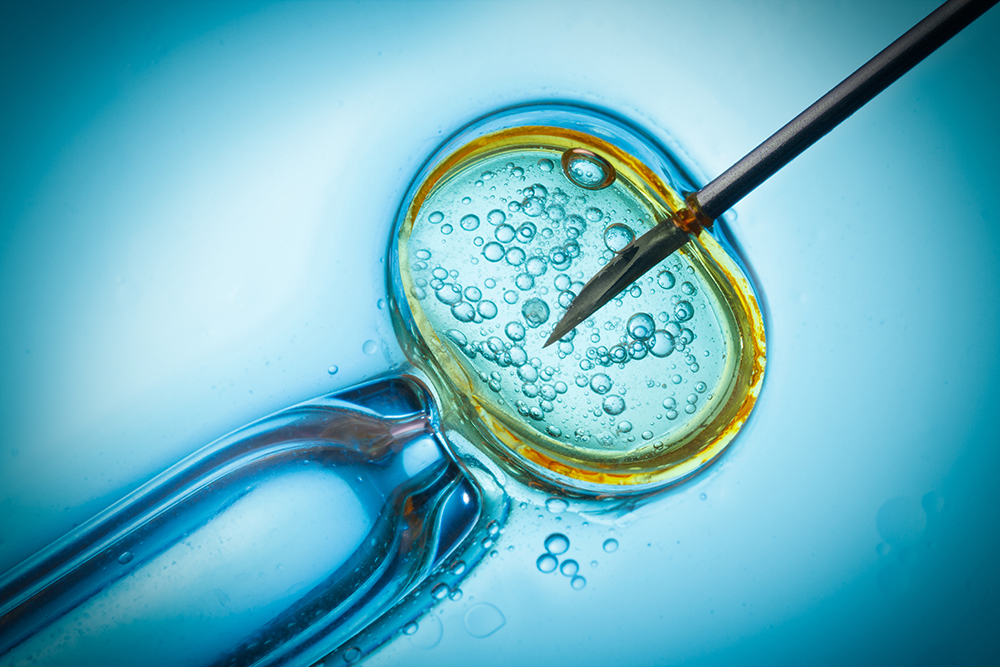
What if you could assess your future child's genes with a pre-pregnancy test? Preimplantation genetic diagnosis (PGD) makes this a possibility for couples undergoing in vitro fertilization. "PGD is a way to screen human embryos for a specific genetic disease before they are implanted into a woman's uterus," says Dr. Jennifer Kulp-Makarov, M.D., a board-certified Ob-Gyn and reproductive endocrinology and infertility specialist at New Hope Fertility. PGD is especially useful if one or both parents has a known genetic abnormality, since it can prevent the disease from being transmitted to children.
What is Preimplantation Genetic Diagnosis?
Preimplantation genetic diagnosis is a technique used "to obtain genetic information about the cells of an embryo before the embryo is used to create a pregnancy," says Eric Flisser, M.D., a board-certified specialist in reproductive endocrinology and infertility and Ob-Gyn at RMA of New York. The procedure is also called preimplantation genetic testing (PGT).
Doctors often use PGD to test for aneuploidy (PGT-A), which occurs when a random genetic error creates an abnormal number of chromosomes in a cell. All normal human cells should have 46 chromosomes, says Dr. Flisser. Embryos without 46 chromosomes either won't form a pregnancy or will have abnormalities that eventually result in miscarriage. "The embryos that have either too many or too few chromosomes will not grow into normal pregnancies," says Dr. Kulp-Makarov. "About half or more of embryos screened in PGD will be non-viable."
Couples may also opt for a type of testing called PGT-M if they're known carriers of a chromosomal abnormality or heritable genetic disorder, such as sickle cell anemia, cystic fibrosis, Huntington's disease, muscular dystrophy, Tay-Sachs disease, and other conditions. Since PGT-M identities embryos affected by these abnormalities, it decreases the risk of transmission to offspring
Another benefit of PGD: "Because the success rate of IVF treatment is so high when normal embryos are identified, only one embryo needs to be transferred at a time," says Dr. Flisser. "This greatly reduces the likelihood of having multiples, making the pregnancy safer for the mother and her fetus." (Pregnancy with multiples increases the risk of preterm labor, birth defects, gestational hypertension, Cesarean delivery, and other complications).
PGD is generally considered a safe procedure. "Many babies have been born after PGD, and their growth and development is similar to children who have not undergone this technique," says Dr. Kulp-Makarov. "But continued longer term follow-up on children born after PGD is recommended to confirm there are no adverse effects."
Who Gets PGD?
PGD is used when a couple undergoes in vitro fertilization (IVF) as a fertility treatment. During this procedure, doctors extract eggs from a woman's uterus, fertilize them with sperm in a petri dish, and insert the resulting embryo directly into a woman's uterus. By screening the embryos through PGD, doctors can identify "genetically normal" ones to use in IVF, says Dr. Flisser.
Many couple opt for PGD if one or both has a known genetic or chromosomal abnormality. What's more, PGD may be recommended for mothers with advanced maternal age or a history of miscarriage.
The PGD Procedure: What to Expect
Doctors perform PGD during the IVF process. After eggs are fertilized in a petri dish, they're placed in a special incubator, says Dr. Kulp-Makarov. The eggs grow for five to seven days until reaching a size of hundreds of cells, called a blastocyst.
At this point, doctors perform a "trophectoderm biopsy" by removing some cells from the area that becomes the placenta (cells that develop into the fetus are not used in PGD.) "The embryo is gently held in place under a microscope using a pipette. A laser creates a hole in the shell around the embryo, and another pipette is used to draw a few cells out and away from the embryo," says Dr. Flisser.
The embryo is then frozen while doctors perform genetic testing on the extracted cells. "A genetic probe is created based on the parents' genes and the disease they are carriers for. This probe is used on the biopsied cells to identify which embryos have the disease, which are carriers for the disease, and which are normal," says Dr. Kulp-Makarov. Embryos without the genetic disease are thawed and transferred into the woman's uterus to complete the IVF procedure.
PGD is about 98-99% accurate for detecting genetic disorders. Couples who opt for PGD should still conduct genetic tests during pregnancy, such as chorionic villus sampling (CVS) and amniocentesis.
How Much Does PGD Cost?
IVF costs about $12,000, plus an additional $3,000 – $5,000 for fertility-boosting medications. PGD increases the overall price tag by thousands of dollars, although Dr. Flisser says the cost varies depending on the type of testing and the number of tests performed. Some insurance companies may cover the costs of PGD; ask your provider for more information.
